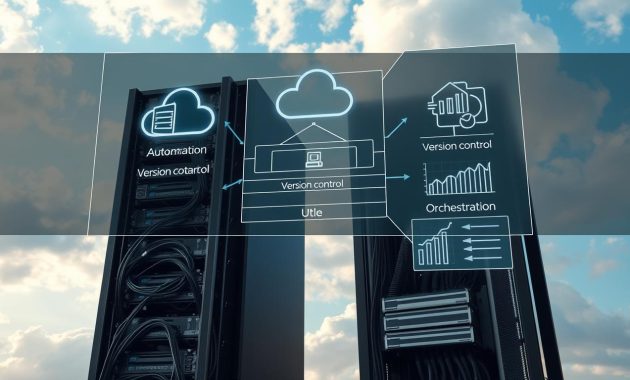In the realm of cloud server configuration management, it is imperative to grasp the foundational principles and methodologies that facilitate the optimization of your infrastructure. These best practices are pivotal for enhancing security, augmenting efficiency, and curtailing costs. By adhering to these guidelines, you can guarantee the efficacy and efficiency of your cloud server configuration management endeavors.
The implementation of best practices for cloud server configuration management entails a series of protocols and procedures designed to optimize the management of your cloud server configuration. Adherence to these practices minimizes risks, reduces downtime, and elevates overall performance. For enterprises heavily reliant on cloud computing, the adoption of best practices for cloud server configuration management is indispensable for achieving strategic objectives.
Embracing best practices for cloud server configuration management ensures that your cloud server is optimally configured, secured, and maintained. This approach precludes common pitfalls, thereby ensuring the seamless operation of your cloud server. With the implementation of optimal best practices for cloud server configuration management, you can concentrate on your business operations, entrusting the management of your cloud server to seasoned professionals.
Understanding Configuration Management in the Cloud
As you navigate the realm of cloud computing, grasping the essence of configuration management is paramount. This discipline is pivotal in guaranteeing the seamless operation of your cloud-based infrastructure. Cloud server configuration management encompasses the meticulous tracking, control, and management of alterations to your cloud resources, including virtual machines, storage, and networking elements. It is indispensable for upholding consistency, security, and adherence to regulatory standards across your cloud-based systems.
Adopting best practices for cloud server configuration management necessitates a focus on several critical elements:
- Automation: Automating configuration management tasks to minimize manual errors and ensure consistency.
- Version control: Tracking changes to your cloud resources and maintaining a version history to ensure accountability.
- Compliance: Ensuring that your cloud-based infrastructure meets regulatory requirements and industry standards.
Implementing these best practices is essential for ensuring the security, efficiency, and regulatory compliance of your cloud-based infrastructure. Effective cloud server configuration management is crucial in today’s rapidly evolving digital environment, where businesses heavily rely on cloud computing to foster innovation and growth. By comprehending the foundational principles of configuration management and adhering to best practices, you can optimize your cloud-based infrastructure, thereby achieving your business objectives.
Key Principles of Cloud Server Configuration Management
In the realm of cloud server configuration management, adherence to certain fundamental principles is paramount. These principles are instrumental in forging a configuration management framework that is both resilient and efficacious. The essence of cloud server configuration management best practices lies in the maintenance of uniform configurations across your systems. This is complemented by the streamlining of configuration tasks and the adaptability of your configuration management system to evolving demands. Achieving this requires a steadfast commitment to consistency, the harnessing of automation, and the pursuit of scalability.
The principle of consistency is of utmost importance in cloud server configuration management. It guarantees that all systems are configured uniformly, thereby minimizing errors and inconsistencies. Automation emerges as a pivotal factor in the streamlining of configuration tasks, enabling the efficient management of your cloud infrastructure. Through the automation of repetitive tasks, you are able to liberate resources, thereby redirecting them towards more strategic endeavors.

The adoption of cloud server configuration management best practices yields a multitude of benefits. These include:
- Enhanced efficiency and productivity
- Improved security and compliance
- Increased scalability and flexibility
By adhering to these principles and implementing cloud server configuration management best practices, you can ensure that your cloud infrastructure is meticulously managed, secure, and scalable. Such an infrastructure is pivotal in supporting your business’s growth and success.
Tools for Effective Configuration Management
In the realm of cloud server configuration management, the selection of appropriate tools is paramount. Adherence to best practices for cloud server configuration management tools is crucial for streamlining processes and maintaining consistency across the infrastructure. Tools that offer scalability, security, and user-friendliness are paramount.
Assessing various options necessitates a thorough understanding of your specific needs and objectives. What are your primary concerns regarding configuration management? Are you in search of a tool that can automate specific tasks or offer real-time monitoring? Understanding your requirements is fundamental to making an informed choice.
Several prominent configuration management tools exist, including Ansible, Puppet, and Chef. Each tool boasts unique strengths and weaknesses. For instance:
- Ansible is renowned for its simplicity and ease of use
- Puppet is a preferred option for extensive deployments
- Chef is celebrated for its high degree of customization and adaptability
When evaluating tools, it is essential to consider factors such as cost, compatibility, and support. Selecting the most suitable tool for your needs ensures efficient, effective, and best-practice-aligned cloud server configuration management.
Setting Up a Configuration Management Strategy
Initiating a cloud server configuration management strategy necessitates a profound comprehension of your management necessities. It is imperative to delineate your objectives, such as augmenting security, diminishing expenditures, or elevating operational efficiency. A meticulously devised strategy will facilitate the creation of a customized methodology, tailored to your distinct requirements, while adhering to the best practices in cloud server configuration management.
Commencing with an evaluation of your current setup is paramount. This entails scrutinizing your existing infrastructure, applications, and workflows. Such an assessment enables the identification of potential enhancements, thereby facilitating the development of an optimized configuration management strategy. This strategy must be in harmony with your overarching business goals and adhere to the best practices in cloud server configuration management.

Defining Your Goals
Establishing clear objectives is a foundational element in the configuration management strategy setup process. It is vital to pinpoint the desired outcomes, such as enhancing security or reducing costs. By setting forth specific goals, you can craft a targeted strategy. This strategy will be designed to address your unique needs and incorporate the best practices in cloud server configuration management.
Assessing Your Current Environment
An in-depth evaluation of your current environment is indispensable in the configuration management strategy setup process. This entails a thorough examination of your existing infrastructure, applications, and workflows to pinpoint areas ripe for improvement. Such an assessment is crucial for determining the most efficacious configuration management implementation methods. It ensures that your strategy is in sync with your business objectives and adheres to the best practices in cloud server configuration management.
Configuration as Code: A Modern Approach
Exploring the realm of cloud server configuration management unveils the critical role of best practices for configuration as code. This methodology entails the management of infrastructure configurations via code, thereby facilitating enhanced version control, augmented automation, and improved collaboration. By embracing configuration as code, you can significantly streamline your configuration management endeavors, thereby elevating the operational efficiency of your cloud-based infrastructure.
Adopting configuration as code necessitates adherence to best practices within cloud server configuration management. Utilizing tools such as Terraform or AWS CloudFormation is paramount for managing infrastructure configurations. These instruments empower you to codify your infrastructure, simplifying its management and upkeep.
- Improved version control: By managing your infrastructure configurations through code, you can track changes and updates more easily.
- Increased automation: Configuration as code enables you to automate repetitive tasks, reducing the risk of human error.
- Enhanced collaboration: With configuration as code, multiple teams can collaborate on infrastructure configurations, improving communication and reducing conflicts.
By adhering to best practices for configuration as code in cloud server configuration management, you can enhance the efficiency and effectiveness of your configuration management processes. This methodology empowers you to manage your infrastructure configurations more adeptly, thereby diminishing the likelihood of errors and augmenting overall system reliability.
Monitoring and Auditing Configuration Changes
Implementing cloud server configuration management necessitates the monitoring and auditing of configuration changes to safeguard the security and integrity of your cloud-based infrastructure. Real-time monitoring and automated alerting are paramount in identifying potential issues before they escalate. Utilizing tools and techniques such as logging and reporting is imperative to maintain vigilance over configuration alterations.
The significance of comprehensive reporting cannot be overstated in the realm of monitoring and auditing. It provides a detailed insight into your cloud server configuration management, encompassing the tracking of changes, the identification of potential security risks, and the adherence to regulatory compliance. Adherence to cloud server configuration management monitoring best practices is essential for the seamless operation of your cloud-based infrastructure.
Key considerations for the monitoring and auditing of configuration changes include:
- Implementing logging and alerting mechanisms to detect potential issues
- Utilizing reporting tools to track changes and identify security risks
- Conducting regular security audits to ensure compliance with regulatory requirements
Adherence to these cloud server configuration management monitoring best practices is crucial for maintaining the security and integrity of your cloud-based infrastructure. It is imperative to remain abreast of the latest tools and techniques to preemptively address potential issues.
Best Practices for Security in Configuration Management
In the realm of cloud server configuration management, the paramount concern is security. It serves as a bulwark against unauthorized access and nefarious activities. Security best practices for cloud server configuration management necessitate a synergy of access controls, regular audits, and vigilant monitoring. These measures are pivotal in safeguarding the integrity and confidentiality of your data.
Securing your configuration management system demands attention to several critical facets:
Implementing Access Controls
Access controls, such as role-based access control and multi-factor authentication, are indispensable in thwarting unauthorized access to your configuration management system. By restricting access to only authorized personnel, you significantly diminish the likelihood of security breaches and data tampering.
Regular Security Audits
Regular security audits are indispensable in uncovering and mitigating potential security vulnerabilities. Through audits, you can identify weaknesses, verify adherence to security protocols, and implement corrective measures to avert security incidents. This ensures the sustained security and integrity of your cloud server configuration management system.
Continuous Improvement and Optimization
Having established effective cloud server configuration management, it is imperative to uphold a continuous improvement and optimization ethos. Regularly soliciting feedback from your team, monitoring system performance, and refining your configuration strategies are essential. These actions ensure your cloud infrastructure remains not only efficient and secure but also in sync with your business’s evolving needs.
Gathering Feedback
It is vital to foster open communication channels within your organization to collect invaluable feedback from developers, system administrators, and end-users. Encourage them to articulate their experiences, challenges, and proposals for enhancing the configuration management process. Such feedback is instrumental in pinpointing areas for optimization and catalyzing significant improvements.
Iterating on Configuration Practices
Adopt an agile and DevOps-inspired methodology in managing your cloud server configurations. Continuously scrutinize and enhance your processes, tools, and automation to address any identified issues or emerging requirements. This approach ensures your cloud infrastructure remains agile and responsive to the dynamic needs of your business.
